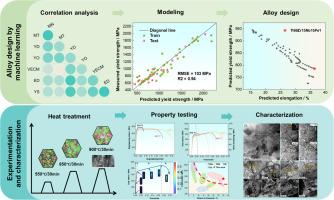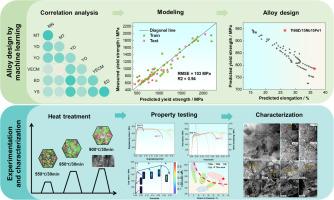通过基于领域知识的机器学习,设计具有特殊强度-延展性平衡的生物医学β-钛合金
IF 9.3
1区 材料科学
Q1 MATERIALS SCIENCE, MULTIDISCIPLINARY
引用次数: 0
摘要
生物医用钛合金的强度和延展性优化是提高生物医用植入物性能的关键。本研究提出了一种新的基于领域知识的机器学习方法来设计Ti-15Zr-15Nb-1Fe生物医用β-钛合金,实现了35%伸长率和700 MPa屈服强度的优异平衡。采用x射线衍射、电子背散射衍射和透射电镜对其相组成和微观结构进行了表征。该研究还探索了机器学习模型的内部机制,并研究了滑移系统与扭结带形成之间的关系。结果表明,多滑移/扭结机制的演化和相互作用促进了均匀变形,动态提高了应变硬化速率,从而协同提高了强度和延性。这些发现强调了机器学习在加速先进生物材料发展方面的潜力,并提供了变形行为的机理见解,为设计下一代生物医学植入物提供了途径。本文章由计算机程序翻译,如有差异,请以英文原文为准。


Design biomedical β-Ti alloys with exceptional strength-ductility balance via domain knowledge-based machine learning
The optimization of strength and ductility in biomedical titanium alloys is critical for improving the performance of biomedical implants. This study presents a novel domain knowledge-based machine learning approach to design a Ti-15Zr-15Nb-1Fe biomedical β-Ti alloy, achieving an exceptional balance of 35 % elongation and 700 MPa yield strength. The phase constitution and microstructure were characterized using X-ray diffractometry, electron backscatter diffraction, and transmission electron microscopy. The study also explores the internal mechanisms of the machine learning model and investigates the relationship between slip systems and kink band formation. Results reveal that the evolution and interaction of multi-slip/kinking mechanisms promote uniform deformation and dynamically enhance the strain-hardening rate, leading to a synergistic improvement in strength and ductility. These findings underscore the potential of machine learning in accelerating the development of advanced biomaterials and provide mechanistic insights into deformation behavior, offering a pathway for designing next-generation biomedical implants.
求助全文
通过发布文献求助,成功后即可免费获取论文全文。
去求助
来源期刊

Acta Materialia
工程技术-材料科学:综合
CiteScore
16.10
自引率
8.50%
发文量
801
审稿时长
53 days
期刊介绍:
Acta Materialia serves as a platform for publishing full-length, original papers and commissioned overviews that contribute to a profound understanding of the correlation between the processing, structure, and properties of inorganic materials. The journal seeks papers with high impact potential or those that significantly propel the field forward. The scope includes the atomic and molecular arrangements, chemical and electronic structures, and microstructure of materials, focusing on their mechanical or functional behavior across all length scales, including nanostructures.
 求助内容:
求助内容: 应助结果提醒方式:
应助结果提醒方式:


